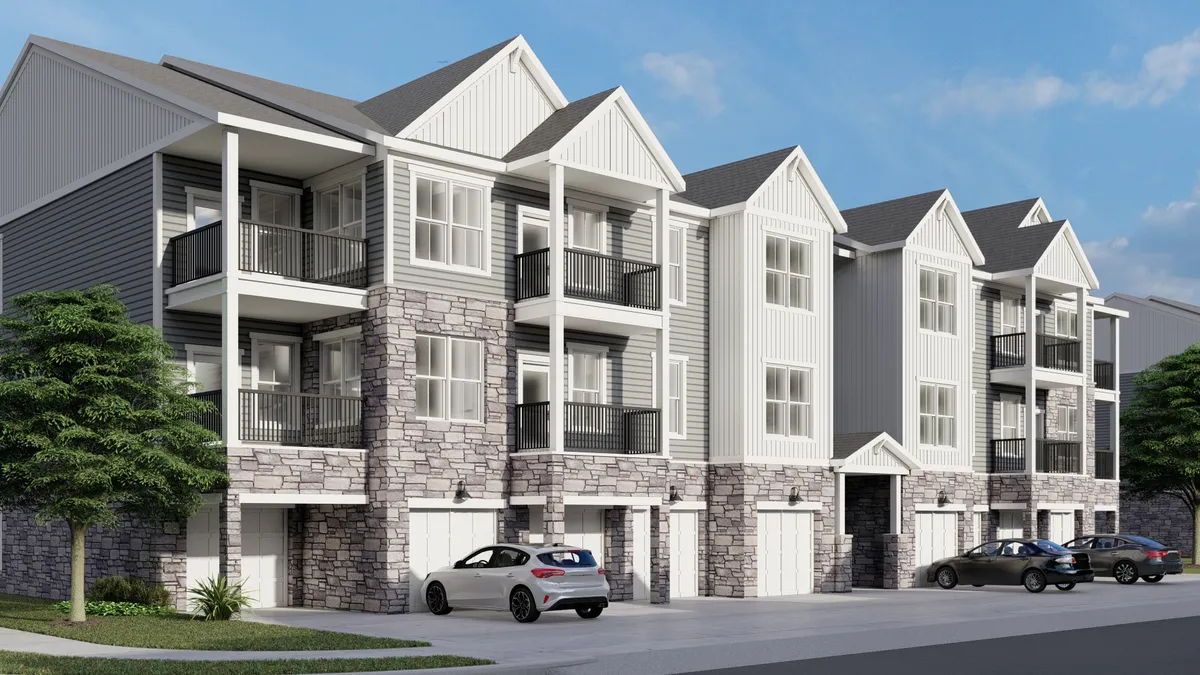For Brian McGinniss, the area manager of Washington, D.C., for Ft. Mitchell, Kentucky-based homebuilder Drees Homes, the supply chain backups started with windows. Then, the appliances were delayed. But the problems don’t end there. It’s also challenging to get things like flooring and shower stalls to the jobsite on time.
As he deals with these issues, McGinniss finds himself and his team at the fulcrum of the supply chain bottleneck.
On one hand, he is trying to get visibility into the backlogs from the subs and suppliers facing challenges getting materials and appliances to the site on time. On the other, McGinniss' team has to work with buyers who are frustrated that their refrigerators and cabinets aren’t arriving as expected.
There is good news, though. The demand is there for the homes that Drees builds. Interest is so strong that Drees, ranked No. 34 on the 2021 BUILDER 100 with 2,322 closings, has been moving into a higher-density product in the D.C. area, including Embrey Mill, an age-qualified, 264 garden-style unit project in Stafford, Virginia (pictured above). Of course, more units means getting more appliances to new homes.
Here, McGinniss talks with Construction Dive about the challenges of getting things like windows and refrigerators to the site and how he is working with buyers and suppliers to overcome supply chain problems.
CONSTRUCTION DIVE: How are materials shortages and supply chain issues affecting your business?
BRIAN MCGINNISS: It has definitely been a struggle. We have had material increases regularly and that has caused a lot of issues for us. There was a time when the trades used to lock pricing for a quarter or six months. And now they won't even lock it until the product is shipped. Say that I sell a house today and it takes us 90 days to get through the permit process. Now, all of a sudden, that's 90 more days of fluctuating costs. It hasn't really been fluctuating down. It's more upward. Depending on how much it goes up, we have a lot of margin erosion occurring right now.
Tell me about how creative you have had to be to get materials and appliances to the jobsite?
We have a national account with Whirlpool. But we’ve got to a certain point where homeowners have come to us and said, 'I can get this. I can get this refrigerator that I wanted to use from Home Depot right now.' And we're like, 'Really? Let's go get it.' And we'll go with them to Home Depot with our corporate credit card, and we will buy them their refrigerator. We get it into the house. Then, we work out the financing and credits with Whirlpool.
As a consumer, you think it’s the other way around. You think the large company has more buying power than you do.
Yeah, it's shocking. You would think you would go directly to the supplier, but it's already in the supply chain somewhere. It's just not with who we need it to be with. It is out there in the market somewhere. It's a matter of us getting our fingers on it.
The suppliers, like Whirlpool, have been very good [when customers are ready to move in]. They will give you a temporary refrigerator. So now, all of a sudden you're moving in and you don't have the refrigerator you want. That eventually comes in and now you have a secondary refrigerator for your garage. For Whirlpool, this is falling on their shoulders. It's an increase in cost to them. So if I can go and get it done at a Home Depot or Lowe's or through Amazon, maybe it becomes more cost-effective than supplying one homeowner with two refrigerators.
When do you know that getting materials and appliances to a site is going to be an issue?
We're finding out the day of [scheduled delivery] that something isn't arriving. The trades may not be as good at communicating the delay to us as they probably should because they're trying to make it work on their side.
We're hoping that we'll be able to make the delivery. When it doesn't [happen], people get frustrated with us because we're the company that sold them the home. They think to themselves, 'Why don't you know this? You should know this.' We really don't. It's not for lack of effort or lack of communication on our part. The supplier or the trade is trying to make it work on their side and is holding out hope.
Have you taken steps to have the subs give you a little more visibility on the issue? How does that help?
Steve Shaner, our operations manager, works very closely with each one of our trades. When cabinets all of a sudden turned out to be a big, big issue, we can still keep moving the process forward, even though we just passed our cabinet install date. If cabinets are running two months behind, it doesn't mean it's a delay of two months because there are a lot of other things that we can do before the cabinets actually go in. So a lot of the trades are supplying this information, and then he's able to share it with the sales team, as well as the builders, which we call our superintendents. We’re also able to share the information with our production team so that we can inform our buyers and give them the heads up.























